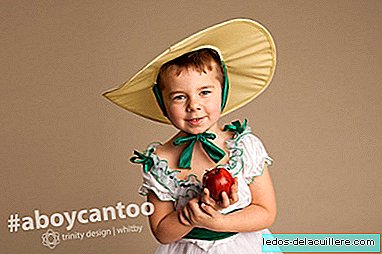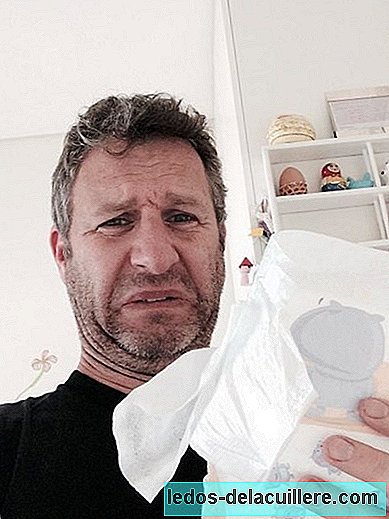
We saw when talking about vegetables and vegetables that these include a large number of foods and that not all are suitable for all ages. At six months the baby can already be offered vegetables such as tubers: potato or potato and sweet potato or sweet potato.
Both vegetables are, for their nutritional properties and their ease of digesting, suitable for babies in the form of purees or porridge at the beginning, after six months.
The potato is usually combined with other vegetables and with meat or fish, and the same with the sweet potato, although in some varieties it has a sweeter taste than the potato.
We will know what are the nutritional properties of these two vegetables, as well as their varieties and its way of preparation for complementary infant feeding.

The potato in infant feeding
The potato or potato (scientific name: Solanum tuberosum) is a plant belonging to the Solanaceae family, native to South America and cultivated throughout the world for its edible tubers. In the Andean highlands it was already cultivated about 7000 years ago, and it was taken to Europe by the Spanish conquerors more as a botanical curiosity than as a food plant.
Over time its consumption has been growing and its cultivation has expanded worldwide to position itself as one of the main foods for humans.
The potato is indicated for feeding the baby after six months because it is easily digested and has a high nutritional value. Potato tubers have approximately 78% water and 18% starch. The rest is composed of varying amounts of proteins, minerals and about 0.1% of lipids (fats).
In addition, the potato contains several vitamins, including vitamin C, riboflavin, thiamine and niacin. Among the different minerals found in the potato, calcium, potassium, phosphorus and magnesium are worth mentioning because of their importance in human nutrition.
Although we are used to seeing the tuber, which is part of the stem underground, the plant consists of other parts, leaves, roots, fruits, seeds and even flowers. We are interested in the tuber, which is the organ of the plant that stores nutrients.
Potato is one of the most important crops in the world. For human consumption it is only surpassed by three cereals: wheat, rice and corn.
Potato varieties
The tubers can have an elongated, rounded or oblong shape and their color also varies in different types of potatoes: white, yellow, violet or reddish.
The experts have developed thousands of varieties, many of which are becoming obsolete by the appearance of others with greater performance and adaptability, so that only a few tens are consumed. The varieties can be distinguished by the color of the epidermis and pulp, resistance to diseases or the duration of the crop cycle.
Modern cultivars are usually rounded, with yellow or pink skin, white or yellow flesh and shallow eyes. Traditional varieties with these forms are also known in the highland countries of the crop, but there are also many others with purple, blue or bicolor skin, bluish, violet or yellow flesh and elongated, curved or almost spherical shapes.
Here you can see some of the potato varieties from Peru or Chile and other Creole varieties.
All kinds of potatoes are suitable for babies, although some varieties may stand out for a somewhat bitter taste that may be more difficult to accept.

Sweet potatoes in baby food
Sweet potato is a tuber that receives several names depending on the area. It is widely known as sweet potato, sweet potato (from Nahuatl camohtli), chaco or sweet potato and is a family plant Convolvulaceae, cultivated for its edible tuberous root.
It is a food that is classified within the group of tubers, but is distinguished from the rest by its characteristic sweet taste due to its high sugar content that, in general, is greater the closer to the equator the growing area is.
The composition of this tuber is very similar to that of the potato, although there are some differences. Sweet potatoes are a natural source of potassium. It contains a lot of beta-carotene (vitamin A) and is very nutritious and rich in antioxidants. Its slow-absorbing carbohydrates and its richness in vitamins provide energy and strengthen health.
The orange color of its pulp denotes that its vitamin A content in the form of beta-carotene is almost as high as that of carrots. Beta carotene helps prevent cataracts, certain types of cancer and cardiovascular disorders. It also improves the immune system. Therefore, orange pulp sweet potatoes are more nutritious than yellow or white ones.
As food for babies, sweet potatoes are indicated due to their ease of digestion, and the sweet taste makes it pleasant, apart from all the beneficial nutritional properties we have mentioned. These properties are maintained after being cooked.
It is native to Central America and arrived in Europe in the 16th century. Currently and according to data from the FAO (Food and Agriculture Organization of the United Nations), China is the main producer (83% of the world market). Although sweet potato is grown in more than 100 countries around the world and has more than 400 different varieties.
Preparation of the potato and sweet potato for the baby
Sweet potatoes and potatoes should not be eaten raw. Potatoes and sweet potatoes should cook with little water to take advantage of the cooking broth, in which part of the mineral salts are dissolved. Most of the nutrients are inside the tuber, so it is convenient to peel and wash them before introducing them into the water. The skin is harder to digest.
They can also steaming and that way nutrients are better preserved. They can be combined with other vegetables suitable from six months, such as peas, green beans or zucchini.
The cooking time depends on the hardness of the water we use and the type of pot, but the right measure is when they are very soft. You can add a teaspoon of raw olive oil to the puree, but never salt, until after the year.
Regarding the industrial preparations of mashed potatoes, is a variant, a semi-elaborated product in the form of flakes or powder and that only needs hot water or milk for its preparation, just before being served.
But through the manufacturing process monoglycerides are added that are responsible for improving the flavors on the palate, antioxidants such as ascorbic acid (Vitamin C that is lost) as well as citric acid are added so that it can be preserved, and finally dyes, as well as phosphates, so it is not recommended for such small babies.












